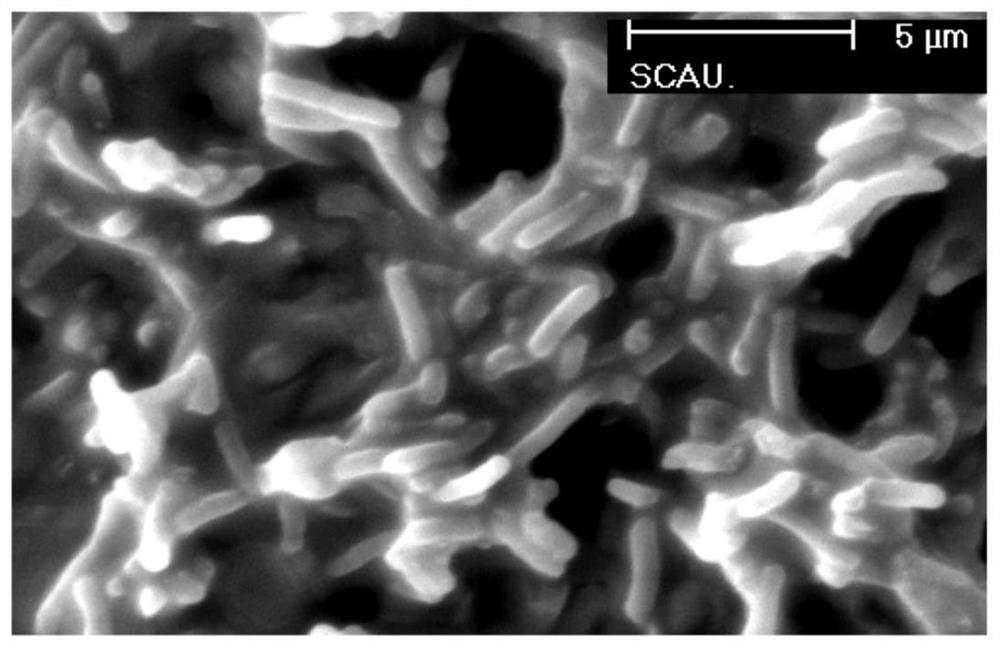A method for expressing antibacterial peptides by using sumo fusion
A technology of antimicrobial peptides and fusion proteins, which is applied in cationic antimicrobial peptides, hybrid peptides, fusion with degradation motifs, etc., can solve problems such as degradation, small molecular weight of antimicrobial peptides, and toxicity of host bacteria, so as to improve folding rate and reduce Toxicity, the effect of increasing expression yield
- Summary
- Abstract
- Description
- Claims
- Application Information
AI Technical Summary
Problems solved by technology
Method used
Image
Examples
Embodiment 1
[0025] Example 1: Design and Screening of Antimicrobial Peptides
[0026] The present invention takes the antibacterial peptide LL-37 as the starting polypeptide, and designs a new antibacterial peptide LLv by adding hydrophobic residues and positively charged amino acids. Compared to LL-37, LLv increases stability and elongates the α-helical structure. The amino acid sequence of the modified antimicrobial peptide is as follows (SEQ ID NO: 1): LLGDFFKKSKEK IGKEFKRIVQRIKDFLRNLVWKTEK.
[0027] By adding hydrophobic residues and positively charged amino acids, the new antimicrobial peptide LLv increases thermal stability compared to LL-37. Antibacterial peptide LLv has certain activity at pH 2.0~12.0. The antibacterial activity did not change significantly after 40min of boiling water bath, and the structure and antibacterial activity of antimicrobial peptide LLv could not be destroyed by high pressure at 121℃ for 21min.
Embodiment 2
[0028] Example 2: Analysis of physicochemical properties of antimicrobial peptide LLv Antibacterial test
[0029] 1. The antibacterial properties of the antimicrobial peptide LLv were detected by the dilution method antibacterial test. The specific steps are as follows:
[0030] 1) Bacterial liquid preparation, inoculate experimental bacteria (Escherichia coli ATCC25922, avian-derived Escherichia coli O1, O2, Pasteurella, Bacillus subtilis, Staphylococcus aureus ATCC25923) into MH broth, place a shaker incubator, and incubate at 37°C 12-18h, so that the bacteria are in the logarithmic growth phase. Dilute the bacterial solution with sterile normal saline to the desired bacterial count.
[0031] 2) Determination by microdilution method
[0032] Take a sterile 96 polystyrene microplate test tube, and add the filter-sterilized chromatographically purified antimicrobial peptide solution to the MH broth medium in turn, so that the final concentrations of the first to the tenth we...
Embodiment 3
[0041] Example 3: Scanning Electron Microscopy of Antimicrobial Peptide LLv Treated Bacteria
[0042]The antimicrobial peptide LLv at a concentration of 2 μg / ml was incubated with Escherichia coli ATCC25922 for 60 min at 37°C, then the bacterial liquid was collected and centrifuged at 3000 r / min for 10 min for three times, the supernatant was discarded, and 0.06 mol / L phosphate buffer (PH7.2) rinsed 3 times, retained the precipitate, added 2.5% glutaraldehyde to make a bacterial suspension, fixed at 4°C for 4 h, and centrifuged at 3000 r / min, 10 min each time, three times. The detailed method for the preparation of normal bacteria control samples is the same as that of the antimicrobial peptide group. Finally, the bacterial suspension was dispersed with PBS to prepare a suspension. The bacteria were then allowed to sink freely, dried, and sputtered with gold under vacuum. Finally, the bacterial structure was observed by scanning electron microscope, and the working voltage w...
PUM
 Login to View More
Login to View More Abstract
Description
Claims
Application Information
 Login to View More
Login to View More - R&D
- Intellectual Property
- Life Sciences
- Materials
- Tech Scout
- Unparalleled Data Quality
- Higher Quality Content
- 60% Fewer Hallucinations
Browse by: Latest US Patents, China's latest patents, Technical Efficacy Thesaurus, Application Domain, Technology Topic, Popular Technical Reports.
© 2025 PatSnap. All rights reserved.Legal|Privacy policy|Modern Slavery Act Transparency Statement|Sitemap|About US| Contact US: help@patsnap.com



